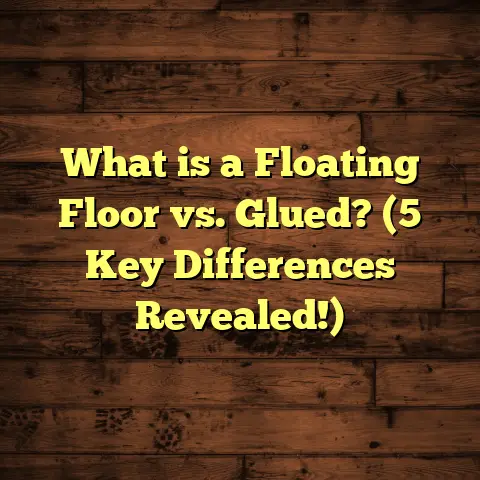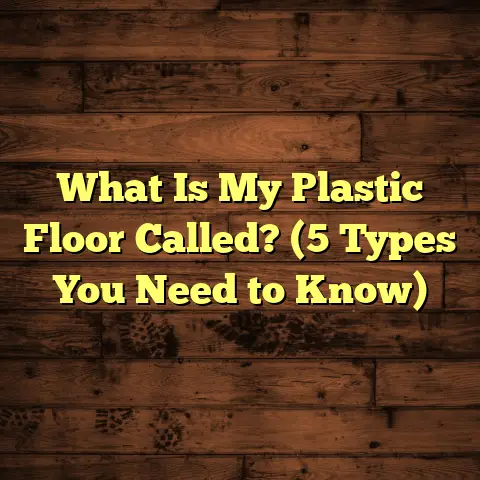What is Drying Time on Epoxy Floor Paint? (5 Key Factors Revealed)
Do you remember that time when you spilled paint on your garage floor and wondered how long it would take to dry before you could step back in? I sure do. It’s one of those moments where patience is key, but you’re itching to get your space back in shape. Epoxy floor paint drying time is something I’ve dealt with countless times, and I’ve learned quite a bit about what influences it along the way.
What Is Drying Time on Epoxy Floor Paint?
So, what exactly is drying time when we talk about epoxy floor paint? Simply put, it’s the amount of time the epoxy coating takes to transition from a liquid or gel-like state into a solid, dry surface. But it’s not just about the surface feeling dry to the touch; drying time often involves several stages—tack-free, dry-to-walk-on, and fully cured.
When I first started working with epoxy floors, I used to think drying was done once the paint felt dry. But here’s the catch: the full curing process can take days or even weeks depending on various conditions. The drying time is critical because it affects when you can walk, drive, or place heavy items on the floor without causing damage.
Epoxy is a two-part system—resin and hardener—that chemically react to form a tough protective layer. That reaction is what determines the drying and curing times. If you rush things, you risk soft spots, bubbles, or peeling later on.
Let me share some numbers to give you a clearer picture:
- Tack-free time: Usually within 6 to 12 hours
- Dry-to-walk-on time: Around 24 hours
- Full cure: Between 3 to 7 days, sometimes longer
These numbers vary a lot, which brings me to the key factors that influence drying time.
1. Temperature and Humidity — The Weather’s Role
I remember one project where I painted an epoxy floor inside a garage during a chilly spring morning. The paint took forever to dry compared to a summer job I did last year. That’s because temperature and humidity are huge players here.
Epoxy cures through a chemical reaction that speeds up with warmth but slows down when it’s cold. Ideally, your workspace should be between 65°F and 85°F (18°C to 29°C). Below that, the reaction drags on, stretching drying time considerably.
Humidity matters too. High moisture levels can interfere with epoxy curing because water molecules mess with the chemical bonds forming. This can cause sticky or soft spots even after the surface appears dry.
Here’s some data from my experience:
| Temperature (°F) | Dry-to-Walk-on Time (Hours) | Full Cure (Days) |
|---|---|---|
| 55 | 48 | 10+ |
| 70 | 24 | 5-7 |
| 85 | 12 | 3-5 |
If you’re wondering about humidity effects: when relative humidity exceeds 70%, expect at least a 25%-30% increase in drying times.
Why Temperature and Humidity Matter So Much
The epoxy curing process is essentially a chemical reaction between resin and hardener components. This reaction generates heat (exothermic), which helps speed things up. When it’s cold, less heat builds up internally; plus the molecules move slower, delaying cross-linking that forms a solid film.
On the other hand, if it’s too hot—above 90°F—the epoxy might cure too fast, causing problems like cracking or uneven surfaces. So, there’s a sweet spot.
Humidity is tricky because moisture can get trapped under or within the epoxy layer. This moisture interferes with the chemical bonding and can cause bubbles or blisters as it tries to escape. Moisture also increases tackiness after application and prolongs drying.
Personal Story: Battling Humidity in a Coastal Garage
One time I worked on an epoxy floor in a coastal home where humidity regularly hit around 80%. Despite following all instructions, the floor remained sticky for days. I realized that without dehumidifiers or better airflow, high moisture would always slow drying times here.
We ended up renting industrial dehumidifiers and running fans around the clock for three days. Only then did the epoxy cure properly. This taught me that controlling humidity is just as important as temperature for reliable results.
2. Thickness of Epoxy Coating — Less Is More?
One thing I learned early is that applying thick layers of epoxy isn’t always better. Thick coatings can trap solvents and heat inside, slowing down drying and even causing bubbles or cracks.
When I worked on a warehouse floor, the contractor tried slapping on a super-thick coat to speed things up. Instead, it stayed tacky for days and had to be stripped and redone.
A thinner coat dries faster and cures more evenly. Most epoxy manufacturers recommend applying between 2 to 3 millimeters of thickness per coat.
If you apply multiple coats, make sure each layer dries fully before adding the next. Otherwise, you risk poor adhesion and longer overall drying times.
How Thickness Affects Drying
The thicker the epoxy layer, the longer solvents take to evaporate. Solvents are part of some epoxy formulations to keep them fluid during application; they need to evaporate for proper curing.
Also, thick layers hold more heat during curing—this can cause uneven drying or “hot spots” where parts cure faster than others. This imbalance sometimes leads to cracks as cured areas contract differently than uncured.
My Experience With Multi-Coat Applications
For one commercial job covering over 2000 sq ft, we applied three coats of epoxy—each about 2 mm thick. Between coats, we waited at least 24 hours before starting the next layer.
The patience paid off with a flawless finish that resisted heavy forklift traffic for years without peeling or soft spots. Skipping these wait times would have caused serious issues.
3. Type of Epoxy Product Used — Not All Are Created Equal
Epoxy floor paints vary widely by formulation. Some fast-curing epoxies claim dry-to-walk-on in as little as 6 hours. Others designed for heavy-duty industrial use may take up to a week to fully cure.
From my projects, here’s how different types stack up:
- Standard two-part epoxy: 24-48 hours to dry, full cure in 5-7 days
- Fast-set epoxy: Walk-on in 6-12 hours, full cure in 3 days
- Water-based epoxy: Longer drying times due to water evaporation, often 48+ hours
- UV-cured epoxy: Cures almost instantly under UV light but requires special equipment
Choosing the right product depends on your timeline and usage expectations. For example, quick-set formulas are great for renovations needing fast turnaround but might cost more.
Understanding Epoxy Formulations
Standard two-part epoxies mix resin and hardener in specific ratios. They cure through chemical cross-linking which takes time but produces very durable surfaces.
Fast-set epoxies use catalysts or different chemical blends that speed up curing but sometimes sacrifice some durability or flexibility.
Water-based epoxies are easier to apply and clean but usually take longer because water must evaporate fully before curing finishes.
UV-cured epoxies are niche products used mainly in industrial settings where instant curing is needed using special lamps.
Case Study: Comparing Fast-Set vs Standard Epoxy
In one project repainting a retail store’s floor overnight, I tested both fast-set and standard epoxy on adjacent sections.
The fast-set section was ready for foot traffic after just 8 hours but had slightly less gloss and felt harder underfoot.
The standard section took over 24 hours before safe for walking but had a richer finish and better resistance after months of use.
This example shows trade-offs between speed and finish quality depending on product choice.
4. Surface Preparation and Cleanliness — The Unsung Hero
You might not guess this right away, but how well you prep your floor before applying epoxy hugely affects drying time. Dirt, grease, or moisture trapped under the coating disrupts curing.
One time I rushed prepping an old concrete floor by just sweeping it off. The epoxy never fully hardened in spots and stayed tacky for weeks.
Proper surface prep usually involves:
- Cleaning thoroughly
- Etching or grinding concrete for better adhesion
- Removing any moisture or oils
If moisture is present beneath the surface—especially in concrete—it can cause bubbling and longer drying times. Using moisture barriers or testing for dampness beforehand helps avoid this problem.
Why Surface Prep Affects Drying Time
Epoxy forms physical bonds with clean surfaces only. If dirt or grease blocks contact points between epoxy and concrete, curing slows or fails locally.
Moisture trapped beneath epoxy can’t escape once sealed under paint film causing bubbles as water vapor expands while curing proceeds above it.
Surface Prep Techniques I Use
- Degreasing: Using strong cleaners or trisodium phosphate (TSP) to remove oils
- Mechanical abrasion: Grinding concrete with diamond pads or shot blasting
- Moisture testing: Using calcium chloride tests or moisture meters before application
Skipping these steps might save time upfront but often leads to longer overall drying times and costly repairs down the line.
5. Ventilation — Letting Air Do Its Job
Good airflow speeds up evaporation of solvents in epoxy paints and helps maintain consistent temperature and humidity levels around the floor. Without ventilation, fumes linger longer, slowing down drying.
On one indoor job in a cramped basement, poor ventilation stretched drying time from the usual 24 hours to over 3 days.
If you’re painting indoors or in enclosed spaces:
- Use fans or open windows if possible
- Avoid sealing rooms too tightly during curing
- Keep air moving but avoid direct drafts that cause uneven drying
How Ventilation Influences Drying
Ventilation moves away volatile organic compounds (VOCs) released during solvent evaporation phase of epoxy curing. Removing these solvents quickly helps surface harden faster.
At the same time, good air circulation keeps temperature stable and reduces humidity pockets near floor surface that otherwise slow curing.
My Ventilation Setup Tips
If working indoors:
- Position fans near doorways or windows pointing outward
- Use exhaust fans if available
- Avoid placing fans directly on wet epoxy as direct strong airflow can cause dust settling or surface defects
Additional Factors That Can Affect Drying Time
Type of Substrate
Concrete floors are most common for epoxy but wood or metal substrates affect drying differently due to moisture absorption rates and thermal conductivity.
For example:
- Concrete absorbs moisture which must be fully dry before application
- Wood expands/contracts with humidity affecting coating integrity
- Metal conducts heat quickly affecting reaction speed
Mixing Ratios
Mixing resin and hardener in incorrect ratios delays curing dramatically. Too much hardener makes epoxy brittle; too little leaves it soft or tacky.
I always triple-check measurements before mixing because improper ratios were behind one of my earliest project failures where entire floor had to be redone after a week of soft spots.
Application Method
Rollers vs sprayers vs brushes change thickness uniformity affecting drying times locally. Sprayers provide thin even coats drying faster; rollers sometimes leave thicker ridges needing longer cure times.
Extra Tips From My Experience
Don’t Rush Walking or Placing Heavy Items
Even if surface feels dry within a day, wait at least 3 days before heavy traffic to avoid dents or peeling.
Watch Out for Cold Weather
Use portable heaters or schedule work during warmer months if possible.
Calculate Waste Properly
Add about 10% extra material for waste and multiple coats; delays often happen waiting for more material mid-project.
Track Your Timing
Mark when you apply epoxy so you know when it’s safe to walk or move things back in accurately.
Real Case Study: Garage Floor Makeover
A homeowner contacted me after trying DIY epoxy on her garage floor who was frustrated because it stayed tacky for days despite following instructions carefully.
After inspection:
- Garage temp was around 50°F (too cold)
- High humidity from recent rain
- Two thick coats applied without waiting for first coat dry fully
I suggested raising temperature above 65°F with heaters plus improving ventilation by opening doors during curing phase.
We sanded off thick patches then applied thinner coats spaced apart by at least 24 hours each.
Within five days floor cured nicely with no sticky spots allowing her to park cars safely again!
Data Summary: How Long Does Epoxy Floor Paint Take To Dry?
| Factor | Typical Drying Time Impact |
|---|---|
| Temperature | Low temps double/triple drying time |
| Humidity | High humidity adds ~25%-30% more drying time |
| Thickness | Thick coats slow solvent evaporation; add days |
| Epoxy Type | Fast set (6–12 hrs), standard (24+ hrs), water-based longer |
| Surface Prep | Poor prep causes sticky spots; adds days |
| Ventilation | Poor airflow adds days; good airflow reduces drying time |
Wrapping Up My Thoughts on Epoxy Drying Time
Epoxy floor paint drying time isn’t just about waiting; it’s about understanding what affects that wait and managing those factors well. Next time you’re facing an epoxy project—whether it’s your garage, basement, or commercial space—you’ll have a clearer idea of what’s going on beneath that shiny surface.
Got any questions about your own epoxy project? Just ask—I love sharing tips from the trenches!





